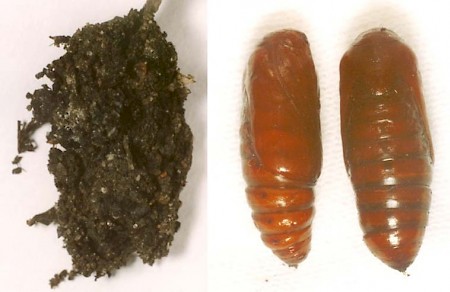
73.368 BF2136
The Gothic Naenia typica
(Linnaeus, 1758)
Wingspan 33-40 mm.
Quite similar in appearance to the Bordered Gothic (Heliophobus reticulata) and the Feathered Gothic (Tholera decimalis), this species can be identified by its broader wings and dark patch between the forewing stigmata.
Inhabiting waste ground, suburban habitats and marshy areas, it is widespread in Britain and Ireland, but may appear less common than it is, because it is not as readily attracted to light as some species.
Specimens may be found from June to early August, nectaring at flowers, or at sugared posts and ropes.
- Larva: (description Ian F. Smith):
The larvae feed on a wide range of plants, including dock (Rumex), dandelion (Taraxacum), Sow-thistle (Sonchus), primrose (Primula vulgaris), Buddleia (Buddleia davidii), Michaelmas daisy flowers (Aster novi-belgii), ragwort flowers (Senecio), hawthorn (Crataegus), sloe (Prunus spinosa), sallow (Salix) and apple (Malus). The larval stage lasts from late July to April, feeding continuing over winter during mild weather. Early instar larvae are easily detected by day and night on plants, feeding gregariously and 'windowing' large areas of leaf. However, the early instars are often not recognised, as they do not resemble published pictures of the larvae, which are usually of the later instars. Older larvae are often overlooked in autumn and winter, when they live on the ground, feeding at night on fallen wilted leaves in preference to standing living vegetation.
Early instar larvae, under about 10 mm, are dull greenish with a broken whitish dorsal line, a light lateral line and a large purplish black spot on the side of each abdominal segment, except segments A9 and A10. The dark spot is largest on abdominal segment A1, and persists as a broadening of the spiracular line in later instars. Larger larvae are olive-brown to pale greenish grey with a thin wavy black spiracular line, thinly edged below by white, and with a wider pinkish line below that. There are many small whitish flecks, the most distinct often being a subdorsal spot on the anterior of thoracic segment T3. Sometimes indistinct pale chevrons can be discerned dorsally, and a pinkish tint may be present intersegmentally. The posterior of abdominal segment 8 is a transverse ridge with pale posterior and blackish anterior faces. Abdominal segments 9 & 10 are often paler dorsally than other segments. The venter is paler than the dorsum on all instars. The spiracles of full-grown larvae are orange edged with a black peritreme. The orange is lacking or pale in early instars, being easiest to discern in the large spiracle on abdominal segment 8.

 UKMoths
UKMoths 










